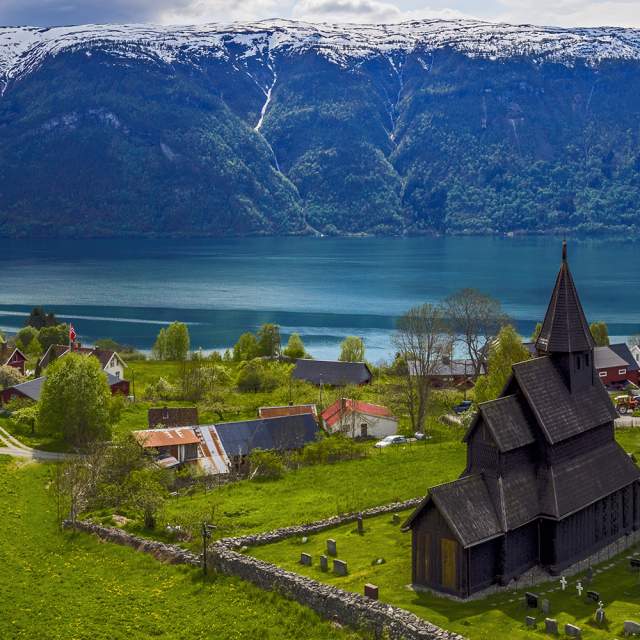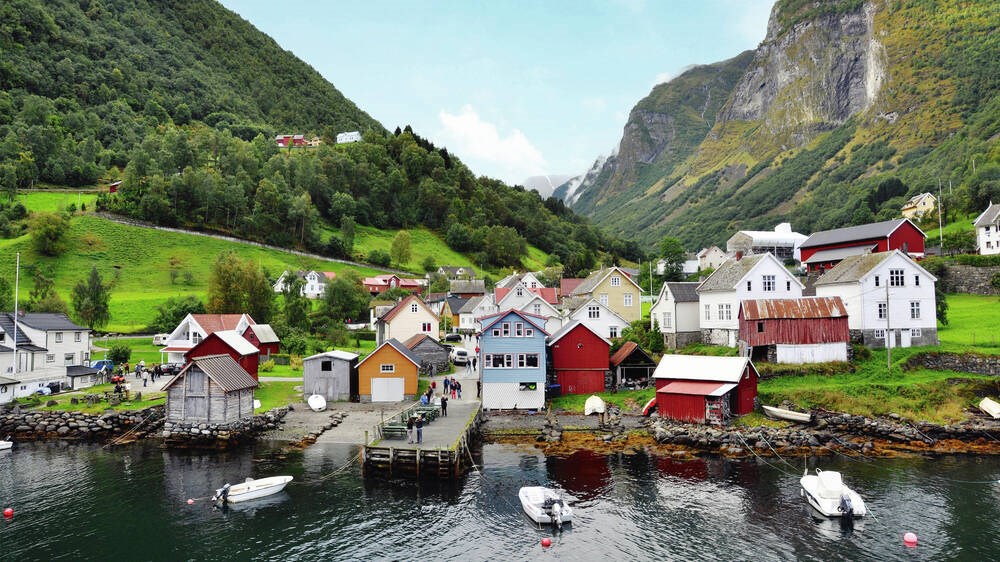Norway: A Journey Through Time and Nature
 Norway, a country known for its breathtaking landscapes, rich history, and vibrant culture, stands as a testament to human resilience and the awe-inspiring power of nature. From its ancient origins to its modern-day innovations, Norway offers a unique story, one that intertwines with the very essence of its people and the rugged beauty of its terrain.
Norway, a country known for its breathtaking landscapes, rich history, and vibrant culture, stands as a testament to human resilience and the awe-inspiring power of nature. From its ancient origins to its modern-day innovations, Norway offers a unique story, one that intertwines with the very essence of its people and the rugged beauty of its terrain.
The Dawn of History: Ancient Beginnings
Norway's story begins in the mists of prehistory, with evidence of the first human settlements dating back to 11,000 BC. These ancient inhabitants were hunter-gatherers, living in harmony with a harsh, unforgiving landscape. The petroglyphs of Alta, a UNESCO World Heritage site, offer a window into these early days, depicting scenes of hunting, fishing, and spiritual life.
The Viking Age: Seafarers and Explorers
The Viking Age (793–1066 AD) marks a significant era in Norwegian history. Norwegian Vikings, known for their formidable ships, set out across the seas, reaching the far corners of the known world. They were explorers, warriors, and traders, establishing settlements in Iceland, Greenland, and even Vinland, known today as Newfoundland, Canada. This period was not just about raiding; it was a time of cultural exchange and the expansion of Norse influence across Europe.
The Union Era: A Time of Alliances
Following the Viking Age, Norway entered a period of unions with its Scandinavian neighbors. The most notable of these was the Kalmar Union, which united Norway, Denmark, and Sweden under a single monarch. This era was marked by both cooperation and conflict, as Norway struggled to maintain its autonomy within these alliances. The dissolution of the union with Denmark in 1814, followed by a brief but significant union with Sweden, paved the way for Norway's eventual independence.
Independence and Growth: The Path to a Modern Nation
Norway's constitution, adopted in 1814, laid the foundation for its sovereignty, which was fully realized in 1905 when the union with Sweden was dissolved peacefully. The early 20th century was a time of rapid industrialization and social reform. Norway embraced democracy, social welfare, and economic development, navigating the challenges of two world wars and emerging as a prosperous, modern nation.
Natural Splendor: Fjords, Forests, and the Northern Lights
Norway's geography is dominated by dramatic landscapes. The Norwegian fjords, with their deep blue waters flanked by towering cliffs, are among the country's most iconic natural wonders. The northern parts of Norway are home to the magical aurora borealis or northern lights, a natural phenomenon that attracts visitors from around the world. These natural features are not just tourist attractions; they are integral to Norwegian identity and lifestyle.
Cultural Richness: Traditions and Innovations
Norwegian culture is a tapestry of ancient traditions and modern innovations. Traditional crafts, such as woodworking and knitting, coexist with cutting-edge design and technology. Norway's literary and artistic contributions are globally recognized, with figures like Henrik Ibsen and Edvard Munch leaving an indelible mark on the world. Music, too, from classical to black metal, reflects the diversity and creativity of the Norwegian spirit.
Social Model: Equality and Quality of Life
Norway is renowned for its social welfare model, which prioritizes equality, education, and healthcare. The country consistently ranks high in metrics of quality of life, happiness, and economic stability. This success is attributed to a combination of factors, including its robust economy, rich natural resources (notably oil and gas), and a societal commitment to egalitarian principles.
Environmental Stewardship: A Green Future
Facing the challenges of the 21st century, Norway has emerged as a leader in environmental stewardship and sustainability. The country aims to balance its economic activities, especially in the oil and gas sector, with a commitment to green energy, conservation, and sustainable development. Initiatives like electric vehicle incentives, investment in renewable energy sources, and conservation programs highlight Norway's dedication to a greener future.
Conclusion: A Legacy of Resilience and Beauty
Norway's story is one of resilience, beauty, and constant evolution. From its ancient roots to its status as a modern, progressive nation, Norway has navigated the tumults of history and the challenges of the present with grace and determination. Its landscapes inspire awe and respect, reminding us of the power and majesty of the natural world. As Norway looks to the future, it carries forward the legacy of its past, embodying the spirit of exploration, innovation, and a deep respect for the environment. This enduring legacy, coupled with a forward-looking vision, ensures that Norway will continue to captivate and inspire for generations to come.
Condensing the rich tapestry of Norway's history, culture, and natural beauty into a short article means leaving out many details, yet it offers a glimpse into the essence of this remarkable country. Norway's journey from ancient times through the Viking Age and into the modern era showcases a nation that has continually adapted and thrived. Its natural landscapes and commitment to social welfare and environmental sustainability underscore a society that values both heritage and innovation. In every aspect, Norway stands as a beacon of resilience, beauty, and a hopeful vision for the future. Embarking on a journey to explore Norway—a land famed for its breathtaking landscapes, rich history, and vibrant cultural tapestry—reveals a nation that is as diverse as it is beautiful. Nestled in the northernmost part of Europe, Norway is a country where the past and present blend seamlessly, offering a unique experience to those who tread its land. From the majestic fjords that carve through its terrain to the ethereal glow of the Northern Lights, Norway is a testament to the awe-inspiring beauty of our natural world.
Embarking on a journey to explore Norway—a land famed for its breathtaking landscapes, rich history, and vibrant cultural tapestry—reveals a nation that is as diverse as it is beautiful. Nestled in the northernmost part of Europe, Norway is a country where the past and present blend seamlessly, offering a unique experience to those who tread its land. From the majestic fjords that carve through its terrain to the ethereal glow of the Northern Lights, Norway is a testament to the awe-inspiring beauty of our natural world.
The Heartbeat of Nature
Norway's geographical features are as varied as they are dramatic. The country's western coast is dominated by the Norwegian Fjords, deep grooves cut into the land by ancient ice masses, now filled with sparkling saltwater. These fjords, such as the Sognefjord and the Geirangerfjord, are not just marvels of natural beauty but also vibrant lifelines for the communities that nestle along their shores. The fjords have been recognized by UNESCO for their outstanding universal value, underscoring Norway’s commitment to preserving its natural heritage. The Arctic Circle cuts through the northern part of Norway, a region known as the land of the midnight sun for its endless summer days, and conversely, the polar night, where the sun doesn't rise for months during winter. Here, the Northern Lights—Aurora Borealis—dance across the sky, a spectacle that has captivated humanity for millennia. The Sámi people, the indigenous inhabitants of this region, have lived in harmony with this harsh yet mesmerizing landscape for thousands of years, their culture deeply intertwined with the cycles of nature.
The Arctic Circle cuts through the northern part of Norway, a region known as the land of the midnight sun for its endless summer days, and conversely, the polar night, where the sun doesn't rise for months during winter. Here, the Northern Lights—Aurora Borealis—dance across the sky, a spectacle that has captivated humanity for millennia. The Sámi people, the indigenous inhabitants of this region, have lived in harmony with this harsh yet mesmerizing landscape for thousands of years, their culture deeply intertwined with the cycles of nature.
A Journey Through Time
Norway's history is as rugged and profound as its landscapes. From the ancient petroglyphs in Alta, dating back to 5000 BC, to the Viking Age, marked by explorers and warriors who set sail in their iconic longships, Norway's past is a rich tapestry of human endeavor against the elements. The Viking Ship Museum in Oslo offers a glimpse into this era, housing well-preserved vessels that once traversed the North Sea.
In more recent history, Norway’s role in World War II and its subsequent contributions to peace and diplomacy highlight the resilience and forward-thinking nature of its people. The Nobel Peace Prize, awarded in Oslo annually, serves as a testament to Norway’s ongoing commitment to fostering peace and cooperation on the global stage.
Cultural Mosaic
Norwegian culture is a reflection of both its indigenous roots and the influences that have shaped it over centuries. The traditional music, dance, and art of Norway tell stories of life in this northern land, with the Hardanger fiddle and the joik, a unique form of song from the Sámi people, playing integral roles in Norway’s cultural expression.
Norwegian literature, too, has made significant contributions to the world, with the works of Henrik Ibsen, Knut Hamsun, and Sigrid Undset gaining international acclaim. Contemporary Norwegian authors like Jo Nesbø have continued this tradition, captivating readers across the globe. Culinary traditions in Norway are deeply connected to its geography and climate. Dishes such as rakfisk (fermented fish), lutefisk (lye fish), and the ubiquitous kjøttkaker (meatballs) showcase the Norwegian approach to cuisine: simple, hearty, and closely tied to the natural environment.
Culinary traditions in Norway are deeply connected to its geography and climate. Dishes such as rakfisk (fermented fish), lutefisk (lye fish), and the ubiquitous kjøttkaker (meatballs) showcase the Norwegian approach to cuisine: simple, hearty, and closely tied to the natural environment.
















![[LIVE] Engage2Earn: Save our PBS from Trump](https://cdn.bulbapp.io/frontend/images/c23a1a05-c831-4c66-a1d1-96b700ef0450/1)








































